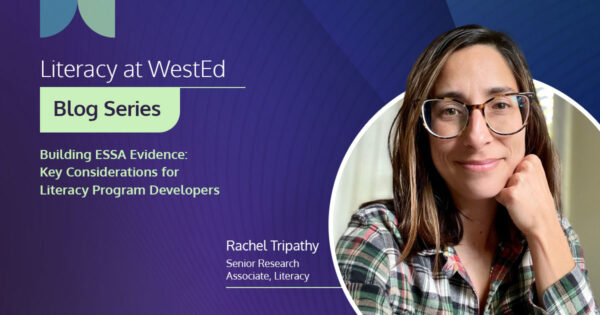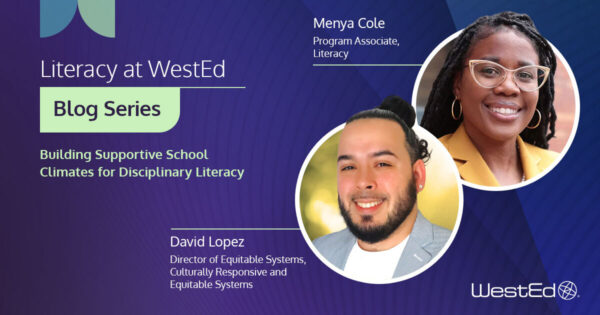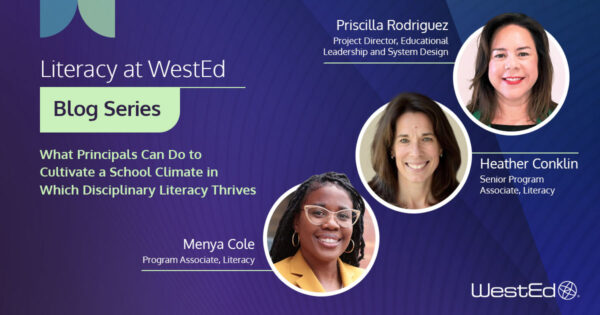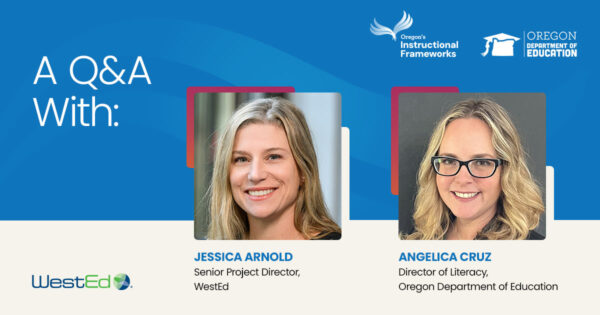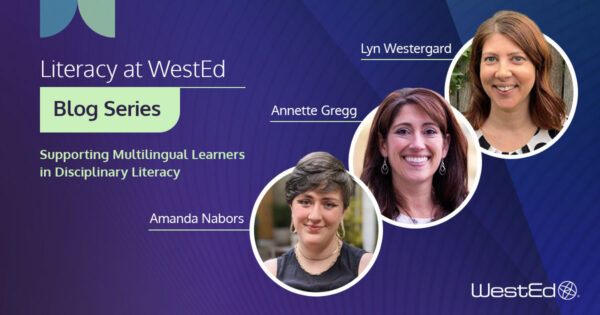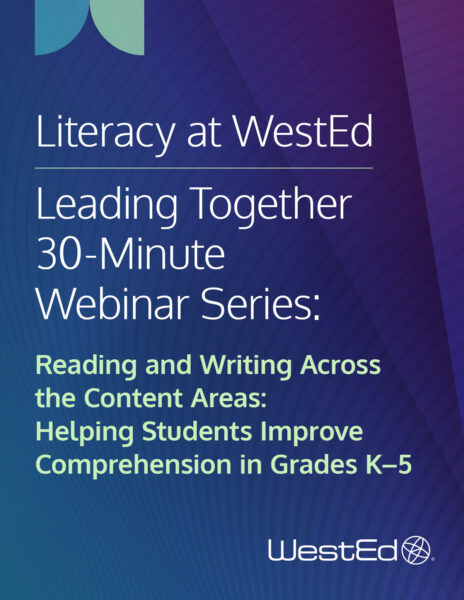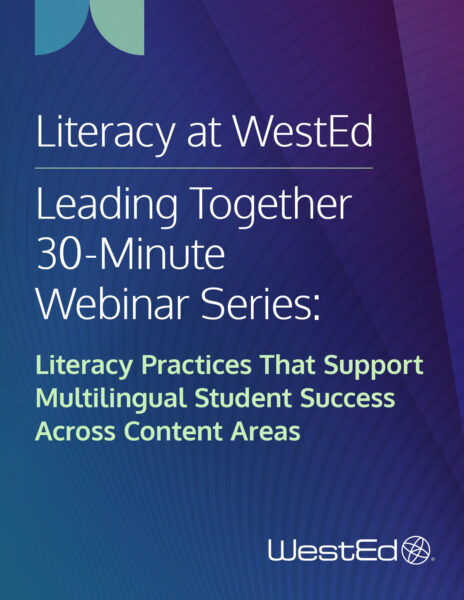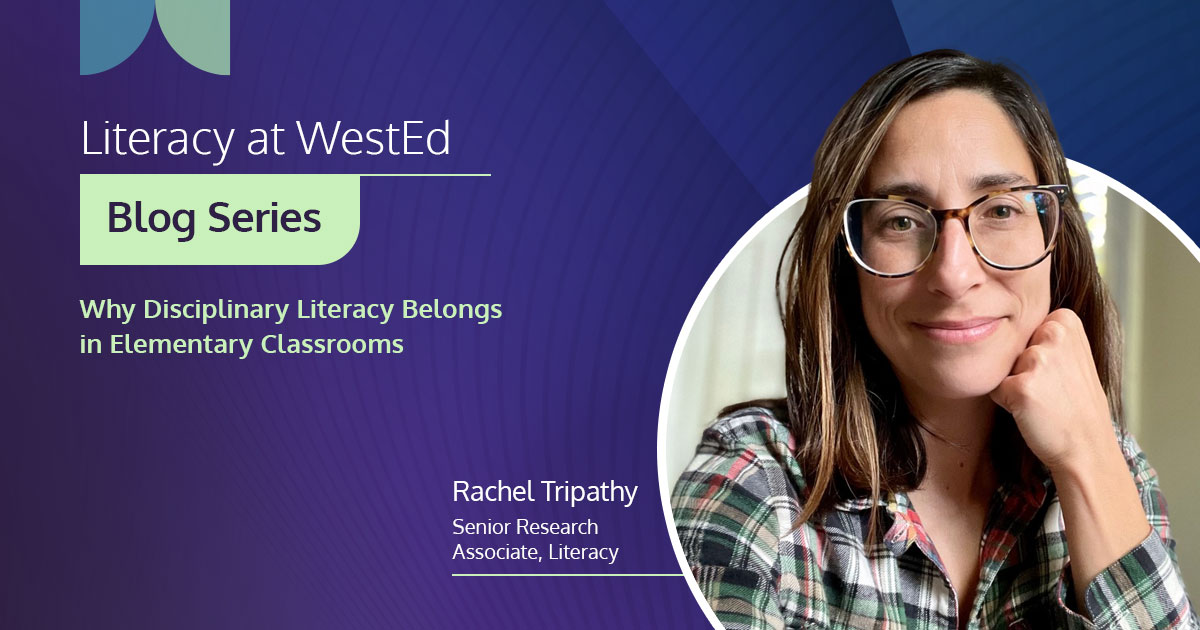
July 17, 2025
By Rachel Tripathy
This blog series explores the concept of disciplinary literacy—the distinct ways of reading, writing, and communicating across academic fields such as science, history, math, and literature. Featuring actionable insights from WestEd thought leaders, the series looks at how integrating disciplinary literacy practices into elementary and secondary classrooms can support student success in school, in careers, and throughout their lives.
When most educators hear “disciplinary literacy,” they immediately think of middle and high school students analyzing primary sources in history class or reading and writing complex scientific texts. But what if we told you that powerful applications of disciplinary literacy are happening in kindergarten through 5th grade classrooms—and that this approach might be exactly what our youngest learners need to thrive?
What Is Disciplinary Literacy?
Disciplinary literacy refers to the specialized ways that reading, writing, and oral language are employed in disciplines like biology, history, or literature (Shanahan, 2019). Unlike general literacy instruction that treats reading and writing as universal skills, disciplinary literacy recognizes that a scientist reads differently than a historian, and an artist communicates differently than a mathematician.
When scientists read, they’re looking for evidence to support or refute hypotheses. When historians analyze texts, they’re questioning the source, considering the context, and seeking multiple perspectives. When artists engage with visual texts, they’re interpreting symbols, examining techniques, and exploring emotional responses.
These aren’t just different content areas—they’re different ways of thinking, reasoning, and communicating. And those skills that students need to read and write like experts in the field must be taught.
The Science of Reading Connection
Here’s where disciplinary literacy aligns beautifully with what we know from the science of reading: Background knowledge is crucial for comprehension. Research consistently shows that students need both decoding skills and rich content knowledge to truly understand what they read (Smith et al., 2021). But here’s the key insight: That content knowledge isn’t just facts and vocabulary. It’s also understanding how knowledge is constructed and communicated within different fields.
When we teach disciplinary literacy in elementary grades, we’re building both content knowledge and the metacognitive awareness of how different disciplines approach learning. This approach mirrors what WestEd’s Reading Apprenticeship does at the middle and high school levels—modeling discipline-specific ways of reading while building student metacognition around those discipline-specific cultures. While Reading Apprenticeship is currently focused on secondary students, the same principles of making thinking visible and apprenticing students into disciplinary ways of reading apply powerfully to elementary learners.
Research supports this early intervention approach. Kim and colleagues’ (2023) sustained and spiraled content literacy intervention, which emphasizes building domain and topic knowledge schemas across elementary grades, led to significant gains not just in content areas but also in general domain reading comprehension and even mathematics achievement. These findings suggest that when students develop a deep understanding of how different disciplines construct and communicate knowledge, the benefits transfer across academic domains.
What This Looks Like in Elementary Classrooms
Let’s step into a 2nd grade classroom where students are investigating this question: “Why is the ground by the slide always muddy?”
Teacher: We’ve been noticing that the area around our slide stays muddy even when other parts of the playground dry up quickly. What have you observed?
Jamal: It’s always squishy there, even when it didn’t rain for, like, 3 days.
Teacher: That’s an interesting observation, Jamal. You’re beginning to gather evidence, just like a scientist does. What else do you notice about that area?
Aisha: It’s really dark there because of the big trees.
Marcus: Yeah, and the swings are in the sunny part, and they’re never muddy.
Teacher: So, we have two pieces of evidence: The slide area stays muddy longer, and it’s shaded by trees, while the swings are in the sun. What do you think might be happening?
Jamal: Maybe the sun helps dry things up?
Teacher: That’s a scientific hypothesis, Jamal! How could we test that idea? What other evidence would we need?
Aisha: We could put water in two cups—one in the shade and one in the sun—and see which one dries up first!
Marcus: And we could measure how much water is left each day!
Teacher: That’s right! When we go back to our classroom, we’ll delve into some reading that will give us more information about our observations.
This isn’t just a science class with some writing thrown in. These students are learning to think like scientists—making observations, forming hypotheses, and designing investigations. They’re also learning that scientific language has specific features (precise observations, cause-and-effect reasoning) and that scientific claims require evidence from systematic investigation.
Research found that when kindergartners have regular opportunities to think and talk like scientists, they were significantly more likely to provide scientific explanations in their talk and apply new science vocabulary in context (Wright & Gotwals, 2017b). Research (including that which we do here at WestEd) has shown that integrating disciplinary literacy instruction into elementary classrooms significantly enhances student outcomes, with students showing measurable improvements in both science vocabulary acquisition and content comprehension compared to traditional science instruction that lacks this literacy focus (Cervetti et al., 2012; Newell et al., 2025).
Why This Matters Now More Than Ever
For elementary teachers, disciplinary literacy offers a solution to the time crunch many feel between literacy instruction and content learning. Studies demonstrate that both literacy achievement and content-area learning benefit when thoughtfully integrated with each other (Hwang et al., 2021). Instead of choosing between reading time and science time, disciplinary literacy allows teachers to develop both simultaneously.
Elementary students encounter different types of texts and thinking patterns across subjects from the very beginning. When we help them recognize these differences early, we prevent the “literacy cliff” that often occurs around 4th grade when texts become more discipline specific and complex.
For district leaders and literacy specialists, investing in elementary disciplinary literacy addresses several critical needs:
- Improved learning opportunities: Young students attending schools with high percentages of students eligible for free or reduced-price lunch receive less science instruction and less vocabulary instruction than do their more economically advantaged peers (Wright & Gotwals, 2017b). Disciplinary literacy can support these students by embedding rich vocabulary and content learning within literacy instruction.
- Multilingual Learners: Disciplinary literacy, together with multimodal opportunities for learning, can empower elementary students who are learning English as an additional language to strengthen their voice and identity in the classroom while providing increased access to challenging topics, unlocking their ability to engage in disciplinary discourse (Kim, 2021).
- Engagement: Using literacy to pursue new knowledge about puzzling phenomena is highly motivating (Burke & Kennedy, 2024). Students become more invested in their learning when reading and writing serve authentic purposes.
- Critical thinking: The Next Generation Science Standards (NGSS Lead States, 2013) and the C3 Framework for Social Studies (National Council for the Social Studies, 2013) align with theory and empirical research demonstrating the importance of supporting elementary students’ language and literacy development during disciplinary learning (Wright & Gotwals, 2017a). Students learn to evaluate sources, consider multiple perspectives, and construct evidence-based arguments—skills essential for civic participation.
Moving Forward
The research is clear: If we seek to support children as long-term participants in a disciplinary community, then students should be apprenticed into disciplinary practices from an early age in a developmentally appropriate manner (Wright & Gotwals, 2017b).
This doesn’t mean elementary teachers need to become content experts in every discipline. It means recognizing that literacy isn’t just about learning to read and write—it’s about learning the specific ways that reading, writing, and thinking work within different knowledge domains.
As one teacher in Burke and Kennedy’s (2024) study reflected: “I think it’s really important in the age that they live in that they’re not just receiving content as this kind of one way of thinking, showing them new ways of looking at information and them being able to evaluate it for themselves” (p. 648).
In our information-rich world, perhaps the most important gifts we can give our youngest learners are the understanding that there are multiple disciplinary-specific ways of making sense of our world and the tools to navigate between them thoughtfully and critically.
Ready to explore disciplinary literacy in your elementary classrooms? Start small with one content area and one driving question that genuinely puzzles your students. Watch how quickly they become invested in reading, writing, and thinking when it serves a real purpose.
If you’re looking for structured support to implement this approach effectively, WestEd’s Reading Apprenticeship program—currently being expanded to grades 1–5—provides the scaffolding and professional development needed to make disciplinary literacy a seamless part of your content area instruction.
Rachel Tripathy is a senior research associate in Literacy at WestEd, where she designs and manages studies of education programs and interventions, with particular expertise in early literacy development and reading policy. Email/LinkedIn
References
Burke, P., & Kennedy, E. (2024). “Why do you think that?” Exploring disciplinary literacy in elementary science, history and visual arts. The Reading Teacher, 77(5), 642–652. https://doi.org/10.1002/trtr.2283
Cervetti, G. N., Barber, J., Dorph, T., Pearson, P. D., & Goldschmidt, P. G. (2012). The impact of an integrated approach to science and literacy in elementary school classrooms. Journal of Research in Science Teaching, 49(5), 631–658.
Hwang, H., Cabell, S. Q., & Joyner, R. E. (2021). Effects of integrated literacy and content-area instruction on vocabulary and comprehension in the elementary years: A meta-analysis. Scientific Studies of Reading, 26(3), 223–249. https://doi.org/10.1080/10888438.2021.1954005
Kim, J. S., Gilbert, J. B., Relyea, J. E., Rich, P., Scherer, E., Burkhauser, M. A., & Tvedt, J. N. (2023). Time to transfer: Long-term effects of a sustained and spiraled content literacy intervention in the elementary grades (EdWorkingPaper: 23-769). Annenberg Institute at Brown University. https://doi.org/10.26300/t3c6-xh48
Kim, S. (2021). Transmodalising pedagogy: Developing STEM disciplinary literacy for young emergent bilingual learners. Bilingual Research Journal, 44(3), 281–297.
National Council for the Social Studies. (2013). The college, career, and civic life (C3) framework for social studies state standards: Guidance for enhancing the rigor of K–12 civics, economics, geography, and history.
Newell, A., Sailors, M., Marek, M., & Moreno, N. (2025). Evaluating the Authentic Literacy and Language (ALL) for Science Curriculum Development Framework effectiveness in developing young children’s science-specific disciplinary literacy and science content knowledge. Baylor College of Medicine.
NGSS Lead States. (2013). Next Generation Science Standards: For states, by states. The National Academies Press.
Shanahan, T. (2019). Disciplinary literacy in the primary school. NCCA. https://www.shanahanonliteracy.com/upload/publications/190/pdf/disciplinary-literacy-in-the-primary-school-professor-timothy-shanahan-university-of-illinois-at-chicago.pdf
Smith, R., Snow, P., Serry, T., & Hammond, L. (2021). The role of background knowledge in reading comprehension: A critical review. Reading Psychology, 42(3), 214–240. https://doi.org/10.1080/02702711.2021.1888348
Wright, T. S., & Gotwals, A. W. (2017a). Supporting disciplinary talk from the start of school: Teaching students to think and talk like scientists. The Reading Teacher, 71(2), 189–197. https://doi.org/10.1002/trtr.1602
Wright, T. S., & Gotwals, A. W. (2017b). Supporting kindergartners’ science talk in the context of an integrated science and disciplinary literacy curriculum. The Elementary School Journal, 117(3), 513–537. https://doi.org/10.1086/690273
